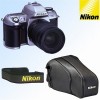Nikon F80QD User Manual - Page 17
Detailed, Operation
 |
UPC - 718122227020
View all Nikon F80QD manuals
Add to My Manuals
Save this manual to your list of manuals |
Page 17 highlights
C O L U M N About Metering System and Exposure Metering systems and exposure are important factors for taking pictures. Knowing the characteristics of each factor helps you widen your photographic expression. •Metering System As the proper combination of shutter speed and aperture for correct exposure is determined according to subject brightness and film sensitivity, measuring subject brightness is very important. In general, brightness inside the viewfinder is not uniform. The F80/F80D/F80S provides three metering systems: Matrix Metering, Centre-Weighted Metering and Spot Metering. With Matrix Metering, scene brightness data is detected by the 10-segment Matrix sensor. With Centre-Weighted Metering, most of the meter's sensitivity is concentrated on the 12mm-diameter centre circle in the viewfinder. Spot Metering sensitivity is concentrated in a small, selected focus area from five available focus areas. Using D- or G-type Nikkor lenses, the F80/F80D/ F80S camera performs 3D Matrix Metering by adding distance information to determine correct exposure. See page 48. • Exposure Light from the subject passes through the lens and exposes the film. Shutter speed and aperture control how much light reaches the film. The combination of shutter speed and aperture appropriate for subject brightness and film sensitivity results in correct exposure-a result provided by the F80/F80D/F80S's four exposure modes: Auto-Multi Progam (page 50), Shutter-Priority Auto (page 52), Aperture-Priority Auto (page 54) and Manual (page 56) exposure modes. When a highly reflective or very low reflective object is within a frame, correct exposure may not be obtained. In such situations, exposure compensation is required. The F80/F80D/F80S offers auto exposure lock (page 58), exposure compensation (page 60) or Auto Exposure Bracketing function (page 61) allowing a photographer greater control of exposure than that afforded by Auto exposure modes. C O L U M N 32 DETAILED OPERATION This section features detailed descriptions of all camera functions-including lens, film, focus, exposure and other functions. 33















